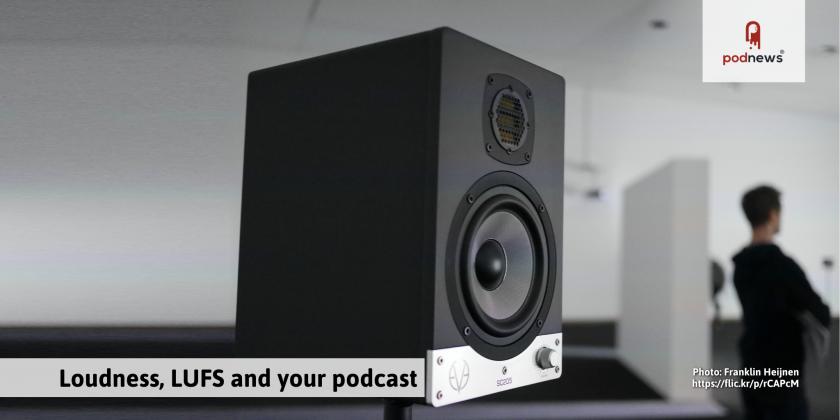
How to do loudness: the LUFS and LKFS FAQ for podcasters

Ever been listening to a podcast and then you get a text message? If that “bing” alert noise was so loud it hurt your ears, then the podcast didn’t set its loudness correctly.
For podcasting, we use loudness to make sure that if you play five podcasts one after another, they all sound as loud as one another - and you shouldn’t need to touch the volume control. It also means sounds much the same as the voice on your smart-speaker, satnav, or the “you’ve got a new text” sound.
LKFS and LUFS relate to the same thing. Most of the world talks about LUFS, so we will too: but the US broadcast industry, particularly, likes to use LKFS instead. (Get with the programme/program).
LUFS describes a measurement of loudness over a period of time.
It’s not dynamic compression, which alters the sound of the audio to be consistently the same volume. It’s also not normalisation, which typically increases the loudest bit of the audio in a clip to be as loud as it can possibly be.
LUFS is a perceptive measurement: “how loud does this sound to your ears”?
How loud should podcasts be?
The podcast industry has mostly standardised on -16 LUFS. This is the loudness level that Apple Podcasts ask for.
Most podcasts use use -16 LUFS in our tests. So, most of them will sound as loud as one another: and, importantly, will work alongside the audio alerts on your phone.
Broadcast radio and television uses -24 LUFS in the US, -23 LUFS in the rest of the world: so if you were to take an audio file made for broadcast radio and upload it as a podcast, it would be too quiet.
Tip: LUFS is expressed in negative numbers, so -26 LUFS is quieter than -16 LUFS.
Tip: Spotify and YouTube ask for -14 LUFS; but most podcasters still produce a -16 LUFS file
I use a PPM or a VU meter to measure my audio level. How do you convert this number to LUFS?
You don’t; because LUFS is a measure of something rather different.
LUFS is a measure of average loudness - “how loud is this audio overall” - and a perceptive feeling of that loudness.
Other forms of metering are concerned with “how loud is this bit right now,” which is not the same thing.
What should I be measuring then?
If you want a simple way of measuring a podcast after you’ve mixed it, the website loudness․info will measure the loudness of your music or podcast.
For monitoring levels while you mix, that’s a different story. If you have a LUFS meter in your audio editor - Hindenburg has one - you’ll see a bewildering amount of numbers.
Apple asks for the “overall loudness” to be -16 LUFS, and most meters will call this the “integrated loudness”. That’s the average loudness from the beginning to the end of your podcast, or after a defined time window.
If you’re mixing audio, you want to be looking at the “short-term” number. That’s the average loudness over the last three seconds. This number is most useful for setting microphone levels.
We’d suggest you mix to the broadcast radio standard (-23 LUFS in Europe, -24 LUFS in the US), which is how most audio editors work. So, set your microphones and other things to that level. When it’s time to export your final podcast, ask your audio editor to output it to -16 LUFS.
Or, mix it to whatever you’re comfortable (dB, PPM, VU), but make sure everything sounds the same level to your ears. Then, ask the audio editor to output it to -16 LUFS. That’s perfectly fine too.
(You’ll need to ensure your audio editor does this properly: you’ll probably want to put some limiting and dynamic compression in your mix anyway, which will ensure your editor is given the tools it needs to output the correct loudness).
What’s the point?
LUFS measures the overall sensation of loudness over a length of time, not the electrical energy of the peak loudness.
That’s important, because it lets you be rather more creative with your audio’s dynamic range.
If you want a really loud explosion, you can have one. If you want very quiet whispering, you can have that, too. The overall LUFS value is set on the average of the whole piece.
You can also make things appear louder by dynamically compressing them to be more consistently loud. This is why the adverts on the TV used to seem so much louder than the programmes: they looked the same on the old meters, but they were subjectively much louder to our ears.
LUFS metering is clever, since it recognises when something has been treated with dynamic compression: that audio will appear to be louder on the LUFS meter, since it sounds louder in real life.
So, whether you heavily dynamically compress your audio, or don’t treat it at all, LUFS metering will work out how loud it really sounds to your ears. That enables podcast producers to make audio which is a wider dynamic range if they want to.
Is it useful for dynamically inserted audio?
Absolutely it is. If all your audio is the same LUFS level, then ads or dynamically-inserted parts won’t sound any different to the rest of the show.
What else should I do?
When it comes to outputting your file, your audio mixing software may let you specify that you want this file at -16 LUFS. (Hindenburg Journalist Pro does, Adobe Audition does too, and so does Audacity). It will listen to your entire audio and work out the right level to output it at so that it hits -16 LUFS.
Alternatively, you can use a service like Auphonic to post-produce your audio to the right loudness level. You can set -16 LUFS in the Auphonic system: it’s the default for new productions. Buzzsprout’s Magic Mastering does the same job.
Apple ask for a +/- 1 dB tolerance, which means that your file can be -15 LUFS or -17 LUFS and it shouldn’t matter.
Apple also ask for a true-peak value not exceeding -1 dB FS. Your post-production software should do this job for you automatically.
I’ve just measured my -16 LUFS file, but it’s -19 LUFS! Why?
You’re working with a mono file.
Mono audio is essentially taking two stereo tracks and adding them together, so mono audio can sound louder than stereo. So, mono files need to be made a bit quieter than stereo files to compensate. To achieve -16 LUFS stereo, your editing program should output -16 LUFS stereo… or -19 LUFS mono.
A mono file at -19 LUFS should sound just as loud as a stereo file at -16 LUFS.
The production process - your audio mixing software - will probably do this work for you when you produce the final mix.
Now, if you put this resulting file into a file analyser that’s built to measure stereo files, it will assume the mono file only sounds as loud as -19 LUFS as a result. This isn’t the fault of your audio mixing software, and is probably the fault of the file analyser.
We’d recommend setting -16 LUFS for everything, and letting your audio mixing software deal with it. In most cases, it knows if you’re making a mono file, and will make changes accordingly. (Auphonic, though, doesn’t do this.)
Tech note: If you use ffmpeg to monitor loudness, there’s an option that says dualmono, which deals with this disparity.
Are there any tutorials I can watch?
- Here’s one for Adobe Audition.
- Here are the details for Hindenburg.
- Here are the details for Audacity. Remember to change it to -16, rather than the default of -23, unless you’re a radio station. (You’re not a radio station).
Further reading
- The Audio Producer’s Guide to Loudness, from Transom, discusses correct settings of LUFS for broadcast radio; part 5 also discusses it for podcasts, though recommends a different LUFS value.
- r128x is a free tool for Mac OS that can measure your podcast’s LUFS values.
Thank you to John Maizels for his kind assistance.





























































































